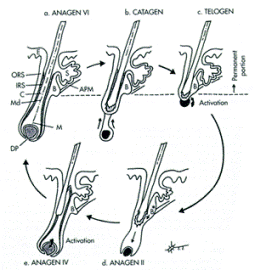Life Cycle of Hair

The life cycle of hair is divided into three phases. The actively growing (anagen) phase, the transitional (catagen) phase and the resting (telogen) phase. During the growth phase, which normally lasts from three to six years, hair will grow about 10mm a month. It is estimated that 85% of the hair on any head at any given time is in the growth phase. At the end of this period, blood supply to the hair bulb slows down and eventually stops. As a result, the hair ceases to grow and moves into the transitional phase, which lasts only about two weeks. Finally, hair enters the resting phase, where it basically just sits on the head for about three months. Then, it falls out, to be replaced by the next budding hair in the growth phase which begins to grow from the same hair follicle. These replacement hairs get finer and thinner due to the DHT impact (explained in "Causes of Hereditary Hair Loss") as a person ages. In most settings of baldness, the hair follicle finally shuts down and refuses to produce more hair to replace the ones that have fallen out. Miniaturised and non-pigmented hair is called vellus hair (peach fuzz), whereas normal healthy developed pigmented hair is called terminal hair.
Shedding
Shedding does not actually mean losing hair. This is one of the most common misconceptions in the world of hair loss. Shedding is in fact just the transition of follicles from the growth phase to the resting phase. Hairs do not fall out and die. They in fact go to sleep, to return several months later. Hair follicles work in cycles as part of their normal processes. Even someone who is not losing his hair goes through the same cycles. The hair will grow for some time and it will rest for some time. In the case of someone not using any treatments but experiencing androgenetic alopecia, shedding is typical of the continuing cyclical process, combined with miniaturisation. This means each time hairs go dormant then come back, they come back weaker, thinner and less pigmented, ultimately resulting in the perception of more scalp skin showing. In view of all this, it is only natural that we lose 50 - 100 hairs daily. People living in temperate zones usually go through an increased shedding phase twice a year, once in spring and once in autumn. During such periods 100 - 150 hairs can be shed every day for a couple of weeks. The number of hairs on the head not affected by hair loss is between 90,000 and 140,000. Blondes have more hair than people with dark hair and red hair. Asians have less hair than Caucasians or Africans. The more hair you have on the head the more you shed. If you start a new treatment like minoxidil, you probably will shed. When minoxidil is applied to stimulate hair follicles, the follicles must regress, shed the old thin hair, rearrange themselves into bigger hair follicles and start making new thicker hair. This inevitably leads to a temporary shedding phase that might seem frightening but which is actually a good sign that the treatment is working.